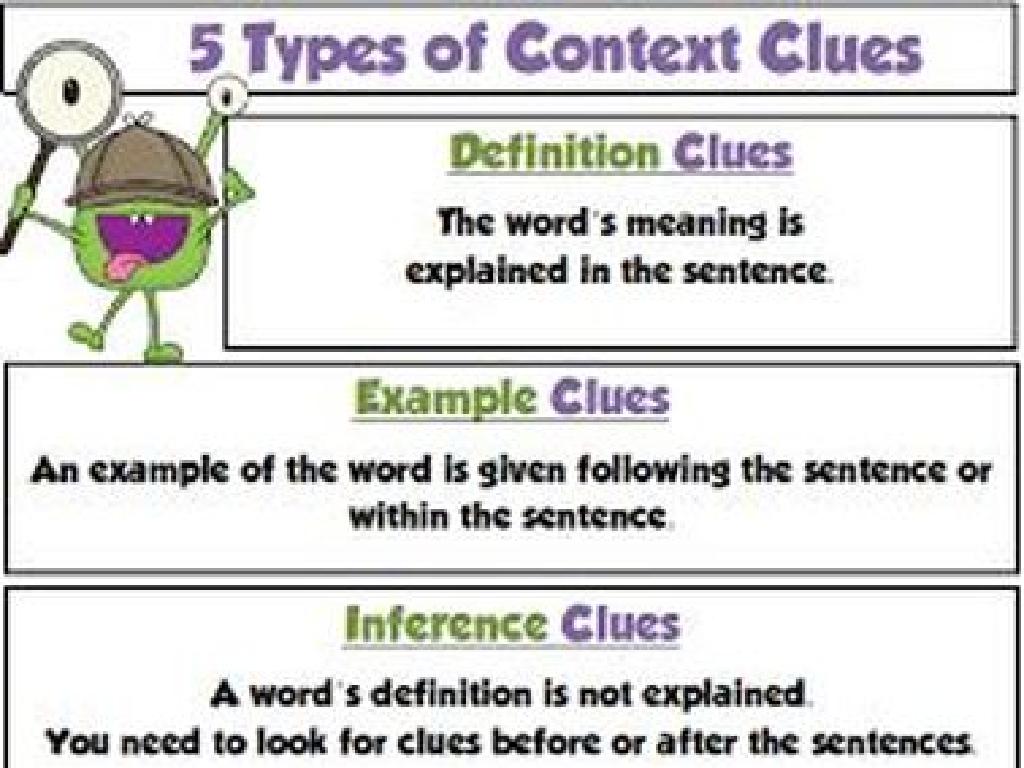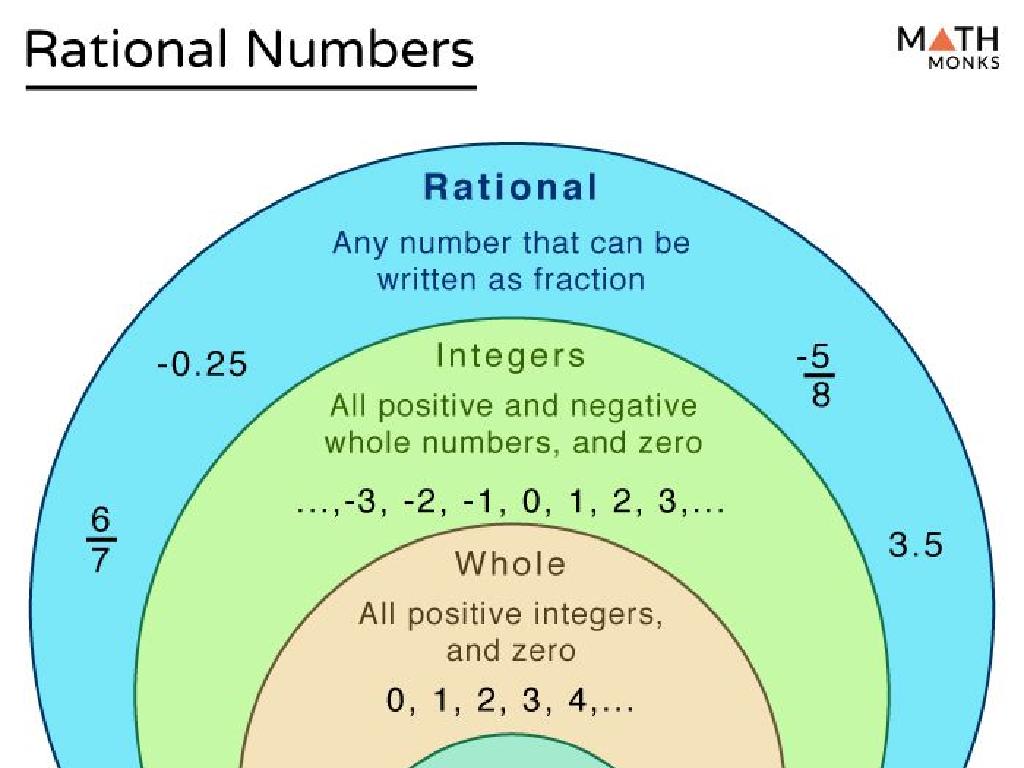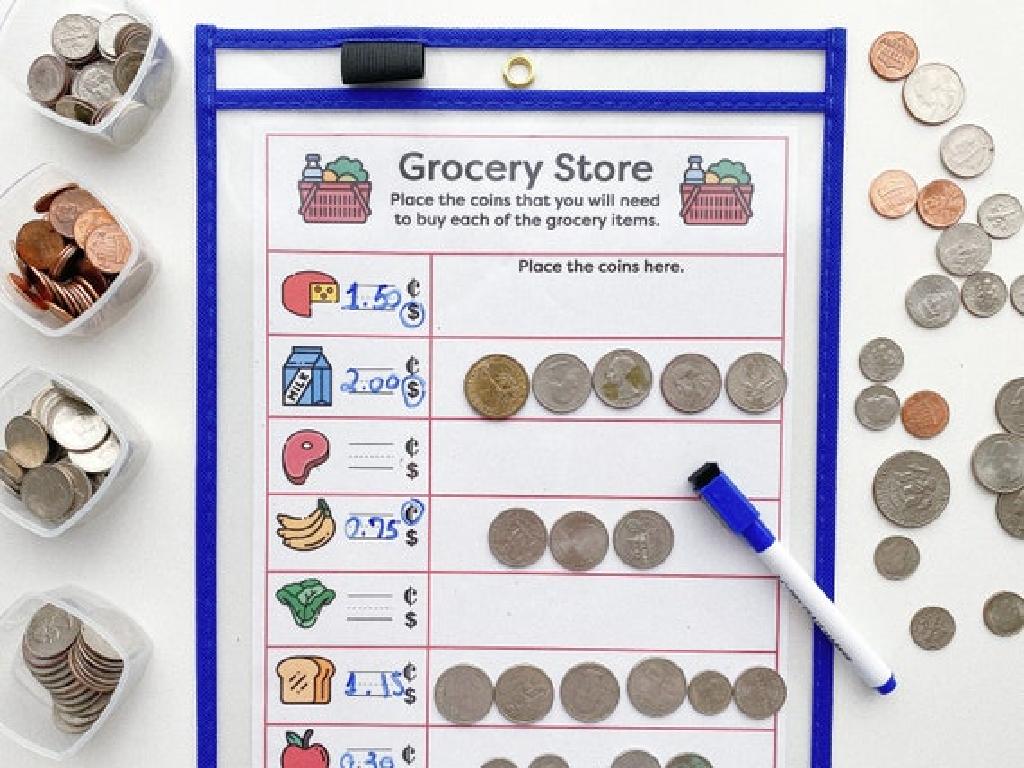Division Patterns Over Increasing Place Values
Subject: Math
Grade: Fourth grade
Topic: Divide By One-Digit Numbers
Please LOG IN to download the presentation. Access is available to registered users only.
View More Content
Welcome to Division: Patterns with Place Values
– Division as equal sharing
– Imagine dividing 10 apples among 2 friends equally.
– Division in daily life
– Think about sharing a pizza or dividing chores at home.
– Recognizing place value patterns
– Notice how dividing by 10, 100, 1000 affects the digits.
– Practice with larger numbers
|
This slide introduces students to the concept of division as a method of sharing equally among a number of people or groups. Provide relatable examples such as dividing apples among friends or sharing a pizza to make the concept more tangible. Highlight the relevance of division in everyday life, such as splitting tasks or sharing resources. Focus on how division affects place values, especially when dividing by powers of 10, and how the digits shift to the right. Encourage students to observe patterns when dividing larger numbers and to use these patterns to solve division problems more efficiently. Include practice problems that reinforce the concept of place value patterns in division.
Understanding Division
– Division: Splitting into equal parts
– Division as ‘fair sharing’
– Example: Sharing 12 cookies
– 12 cookies divided by 4 friends is 3 cookies each
– Each friend gets equal cookies
– Division ensures each friend has the same number of cookies
|
This slide introduces the concept of division to fourth-grade students by relating it to the idea of ‘fair sharing’. Start by explaining that division is a way of splitting things up evenly into groups or parts. Use the example of sharing cookies among friends to illustrate this point in a way that’s relatable to the students. Emphasize that division helps us give the same amount to each person, ensuring fairness. Encourage students to think of other situations where they have shared things equally, like toys or snacks, to further solidify their understanding of division.
Understanding Division Vocabulary
– Dividend: Number to divide
– The total amount you want to split, like 20 apples
– Divisor: Number you divide by
– The number you use to divide, like 5 friends
– Quotient: Division result
– The answer in division, like 4 apples per friend
– Patterns in place values
– As place values increase, notice the pattern in quotients
|
This slide introduces students to the basic vocabulary of division, setting the foundation for understanding division patterns over increasing place values. The dividend is the total amount that you want to split into smaller parts. The divisor is the number of parts you are dividing the total into. The quotient is the result you get after division. It’s crucial for students to grasp these terms as they explore how division works, especially when dealing with larger numbers. Encourage students to use these terms while solving division problems and to observe how the quotient changes as the place value of the dividend increases. For example, dividing 200 by 2 is similar to dividing 20 by 2, just with larger numbers. This understanding will help them recognize patterns and predict results in division as they progress.
Recognizing Division Patterns
– Patterns aid in math predictions
– Quotients change with place value
– As the dividend’s place value increases, the quotient becomes 10 times greater
– Example: 40 ÷ 4 vs. 400 ÷ 4
– 40 ÷ 4 = 10, but 400 ÷ 4 = 100. Notice the pattern?
– Practice with different numbers
– Try 4000 ÷ 4 and see the pattern continue
|
This slide introduces students to the concept of recognizing patterns in division as the place value of the dividend increases. Emphasize the importance of patterns in understanding and predicting mathematical outcomes. Show how the quotient increases tenfold when a zero is added to the dividend in a division by a one-digit number. Use the example provided to illustrate this point and encourage students to practice with different numbers to observe the consistent pattern. This will help them grasp the concept of place value and its effect on division results. Have students come up with additional examples and share their observations.
Division Pattern Rules
– Dividend up by 10, Quotient up by 10
– If 30 ÷ 3 = 10, then 300 ÷ 3 = 100 (10 times more)
– Pattern applies to any place value
– Whether it’s tens, hundreds, or thousands, the rule is the same
– Let’s work through examples
– We’ll solve problems as a class to understand this pattern
|
This slide introduces the concept that when dividing numbers, if the dividend (the number being divided) increases by a factor of 10, the quotient (the result of division) also increases by a factor of 10. This is a fundamental rule that applies to any increase in place value, not just multiples of 10. To reinforce this concept, we will go through examples together as a class. Start with simple examples and gradually increase complexity to ensure understanding. Encourage students to explain why the rule works and to come up with their own examples. This will help solidify their understanding of place value and division patterns.
Let’s Practice Division Patterns!
– Example 1: Divide 30 by 3
– 30 ÷ 3 equals 10. Easy, right?
– Scaling up: What if it’s 300 by 3?
– 300 ÷ 3 equals 100. Notice a pattern?
– Example 2: Divide 50 by 5
– 50 ÷ 5 equals 10. Got it?
– Scaling up: Now try 500 by 5
– 500 ÷ 5 equals 100. What’s the pattern?
|
This slide is a class activity designed to help students recognize patterns in division as place values increase. Start with simple division problems and then scale up by multiplying the dividend by 10. Ask students to solve the first set of problems and then the scaled-up versions. After solving, prompt them to discuss the patterns they observe, particularly how the quotient increases by a factor of 10 when a zero is added to the dividend. This will help them predict quotients for similar divisions. Encourage them to explain the pattern in their own words and provide additional examples if time allows.
Group Activity: Exploring Division Patterns
– Form small groups for activity
– Find patterns in division examples
– Use different numbers to see the division patterns
– Share findings with the class
– Discuss the ‘why’ behind patterns
– Think about place values and how they change the result
|
This group activity is designed to help students recognize and understand patterns in division as they work with increasing place values. Divide the class into small groups and provide each group with a set of numbers to work with. Encourage them to divide the numbers by one-digit divisors and observe the patterns that emerge, especially as the place values increase. Afterward, each group will share their findings with the class, fostering a collaborative learning environment. Facilitate a discussion on why these patterns occur, guiding students to consider the role of place values in division. Possible activities could include dividing multiples of 10 by a single digit, comparing the results, and identifying the pattern of the quotient decreasing by a factor of 10 as the divisor increases.
Class Activity: Division Bingo
– Receive your Division Bingo card
– Solve division problems on the card
– Use division patterns over place values
– Match answers to your Bingo grid
– Check the grid for each correct answer
– Aim for five correct in a row to win!
|
This interactive class activity is designed to help students practice and reinforce their understanding of division patterns over increasing place values. Each student will receive a Bingo card filled with division problems. They must solve these problems, which will require them to apply their knowledge of dividing by one-digit numbers and recognizing patterns as place values increase. As they find the correct answers, they’ll mark them on their Bingo cards. The first student to align five correct answers in a row, either horizontally, vertically, or diagonally, will be declared the winner. For the teacher: Prepare Bingo cards with a variety of division problems. Ensure problems are suitable for fourth-grade level and involve division patterns over increasing place values. Have small prizes ready for winners to keep the activity engaging. Consider having multiple rounds to allow for more winners. Encourage students to double-check their work before declaring ‘Bingo!’ to practice accuracy.
Conclusion: Division Patterns & Homework
– Review division over place values
– Reflect on how dividing numbers changes with place values.
– Patterns simplify division
– Recognizing patterns can help predict results without long calculations.
– Homework: Division Worksheet
– Complete the provided worksheet to practice recognizing division patterns.
|
As we wrap up today’s lesson on division patterns over increasing place values, remind students how these patterns can help simplify division problems. Emphasize the importance of recognizing the consistency in results when dividing by one-digit numbers across different place values. For homework, students will complete a worksheet that reinforces their understanding of these patterns. This practice will help solidify the concept and prepare them for more complex division tasks. Encourage students to look for and use patterns as a strategy to make division easier and more efficient. The worksheet should include a variety of problems that require students to apply the patterns they’ve learned in class.





